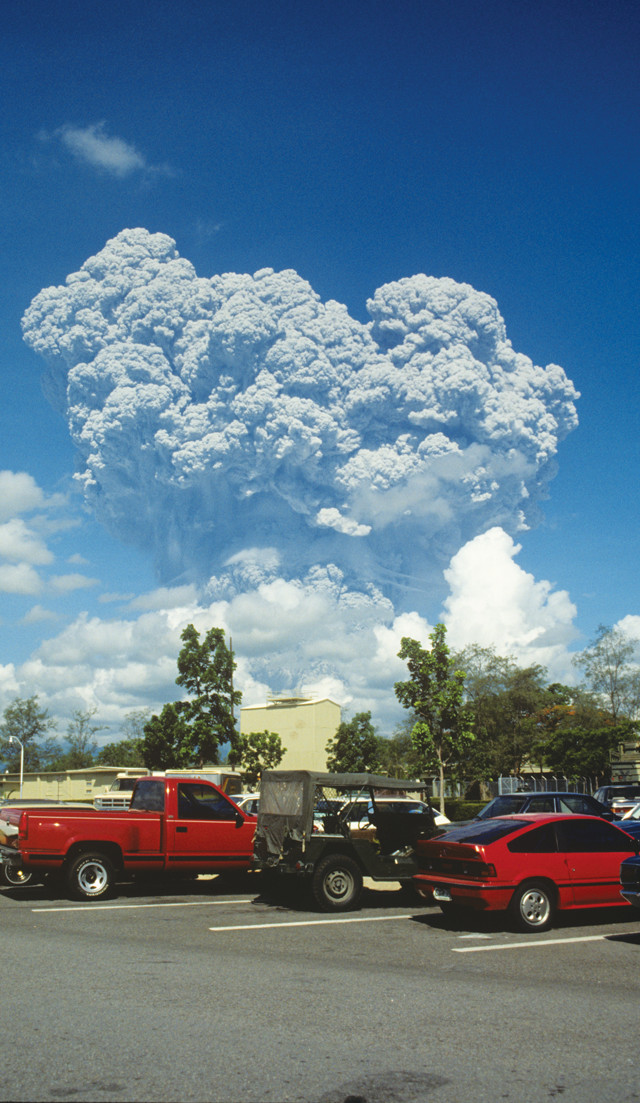
by Mary Caperton Morton Monday, March 19, 2018

Mount Pinatubo in the Philippines is most famous for the explosive phases of its 1991 eruption, but the months-long eruption was also punctuated by gentler periods of oozing lava. Credit: U.S. Geological Survey.
During an eruption, some volcanoes vacillate unpredictably between effusive and explosive behavior. New research has identified a chemical tipping point in some magmas that may trigger the transition between such mild and violent eruptive cycles.
The volcanoes most likely to fluctuate are those fueled by rhyolitic magma, which is rich in silica. “Usually these volcanoes erupt explosively due to the high viscosity of the magma, but sometimes they can erupt effusively,” says Danilo Di Genova, an experimental volcanologist at the University of Bristol in England and lead author of the new study, published in Nature. “We have not been able to adequately explain why the same volcano, or different volcanoes with very similar compositions, sometimes have very different eruptive styles, even though the starting ingredients seem to be the same,” he says.
To get at the root of this problem, Di Genova and colleagues looked at the nanoscale structure of samples of rhyolitic magmas that mimic the compositional range of the Yellowstone volcanic system. The team used Raman spectroscopy, a technique that’s relatively new to earth science but common in materials science, to evaluate the atomic structure of materials. They found that seemingly small chemical differences in the magma — such as the ratio of sodium to potassium or the presence of iron-bearing nanocrystals — can dramatically affect a magma’s viscosity, and therefore its explosivity.
Using thermodynamic modeling, the team showed how small changes at the nanoscale could result in large-scale changes in flow behavior. Such changes could affect the vigor of an eruption by fluidizing a previously locked magma chamber or, conversely, by increasing the explosive potential of a magma by chemically stiffening it. The modeling also showed how iron-bearing nanocrystals can suddenly precipitate in magma and potentially trigger a more explosive eruption by providing nucleation points for gas bubbles.
“When I first reviewed this paper, I was pretty skeptical that the subtle changes they identify could affect viscosity so dramatically,” says Michael Manga, a geophysicist at the University of California, Berkeley, who was not involved in the new study. But when you consider how viscous rhyolitic magma can be, it makes sense, he says. “Anything that makes it flow even a little bit easier can make a huge difference in the eruptive style.”
Di Genova and colleagues also collected previously published data on the chemical composition of rhyolite lavas from 41 volcanoes, including from the Yellowstone complex, Santorini in Greece, and Mount Pinatubo in the Philippines. The researchers were able to classify each as having erupted in either eruptive or effusive bursts based on the criteria they’d determined in their lab studies. “We can clearly separate the eruptive styles, so, thus far, these criteria seem to be universal” for rhyolite magmas, Di Genova says.
“In terms of volcanic risk, we may be able to use this technique to better understand the chemical state of a previously erupted magma and get some idea of how far a volcanic system might be from this tipping point, but it’s not intended to be predictive,” Di Genova says.
Indeed, Manga says, while it might be tempting to use the tipping-point criteria to predict whether a given volcano will erupt explosively or effusively in the future, actually putting this technique into practice is impractical and dangerous. “You would have to wait until the magma reaches the surface to collect samples and make measurements, and at that point, you’re better off standing back and collecting data remotely,” he says.
© 2008-2021. All rights reserved. Any copying, redistribution or retransmission of any of the contents of this service without the expressed written permission of the American Geosciences Institute is expressly prohibited. Click here for all copyright requests.